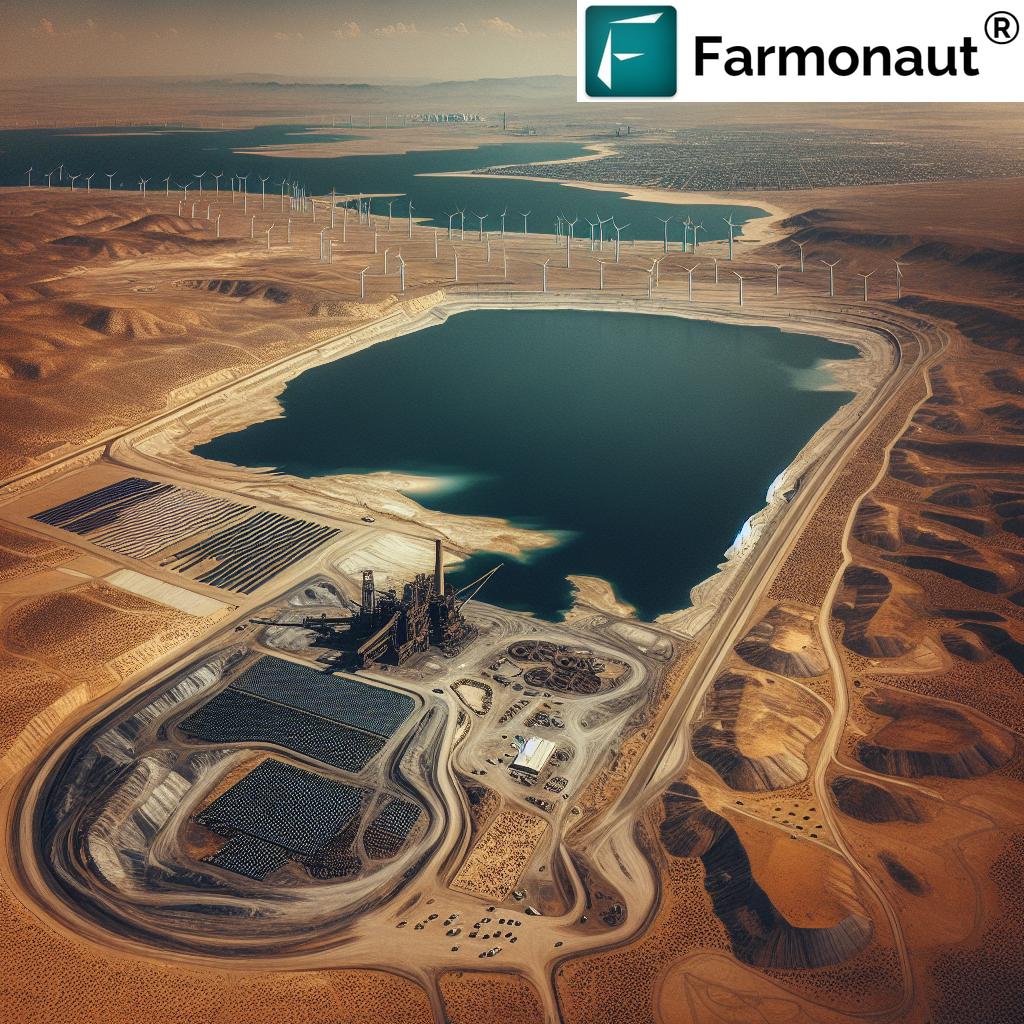Uranium Mining in Arizona: Balancing Nuclear Energy Future and Environmental Sustainability
“Arizona’s uranium mines near Roosevelt Lake could potentially supply fuel for the state’s second planned nuclear reactor.”
As we delve into the complex landscape of uranium mining in Arizona, we find ourselves at the crossroads of energy innovation and environmental stewardship. The resurgence of interest in nuclear energy has cast a spotlight on the dormant uranium mines near Roosevelt Lake and the Sierra Ancha Mountains, presenting both opportunities and challenges for the state’s energy future.
In this comprehensive exploration, we’ll examine the intricate balance between meeting growing electricity demands and ensuring environmental sustainability. From the Grand Canyon to Phoenix’s watershed, we’ll navigate the ongoing debate between industry proponents and environmentalists, offering a nuanced perspective on the future of uranium mining and nuclear power in Arizona.
The Historical Context of Uranium Mining in Arizona
The Sierra Ancha Mountains, east of Roosevelt Lake, hold a significant place in Arizona’s mining history. More than a dozen uranium mines in this region operated during the 1950s and 1960s, playing a crucial role in powering the Cold War era. These mines were instrumental in providing fuel for nuclear weapons, marking a pivotal period in the state’s contribution to national security.
Today, these mines lie dormant, with some entrances wide open and others boarded shut. However, the remnants of their radioactive past linger. Forest Service signs warn visitors against overnight camping due to low levels of radiation remaining in the rock, soil, and water. This historical context sets the stage for the current debate surrounding the potential revival of uranium mining in the region.

The Nuclear Renaissance in Arizona
As we witness a revival of nuclear energy in the United States, Arizona stands at the forefront of this renaissance. The state’s increasing population and growing appetite for electricity have led to plans for a second nuclear reactor. This initiative, spearheaded by Salt River Project (SRP), Arizona Public Service (APS), and Tucson Electric Power, marks a significant milestone in Arizona’s energy landscape.
Bobby Olsen, the associate general manager sustainability executive at SRP, expresses enthusiasm for this development: “We think it’s really critical and exciting.” The planning process for this new nuclear plant is already underway, with projections suggesting it could be operational by the late 2030s or early 2040s.
This move towards nuclear energy aligns with broader efforts to diversify energy sources and reduce carbon emissions. Nuclear power plants, fueled by uranium-235, offer a reliable and low-carbon alternative to fossil fuels. However, the resurgence of nuclear energy also reignites discussions about domestic uranium production and its environmental implications.
The Domestic Uranium Production Landscape
While uranium is found in only about a dozen U.S. states, including Arizona, most of the uranium used in the country currently comes from international sources such as Canada and Russia. However, recent legislative changes are set to reshape this landscape.
In 2024, Congress passed a bill banning most uranium imports from Russia, aiming to jumpstart the domestic uranium mining industry. This move has significant implications for states like Arizona, which possess untapped uranium resources.
Currently, Arizona has one operating uranium mine near the Grand Canyon. However, this mine has been the subject of intense scrutiny and criticism from environmentalists and Native American communities. The primary concerns revolve around its proximity to the Colorado River and the potential for water contamination.
The track record of uranium mining, particularly in regions like the Navajo Nation in northeastern Arizona, has been problematic. Many water sources in this area remain polluted from past uranium mining activities, serving as a stark reminder of the industry’s potential environmental impacts.
Environmental Concerns and Advocacy
“Environmental concerns over uranium mining in Arizona include impacts on water resources and increased radiation levels in surrounding areas.”
The potential revival of uranium mining in Arizona has sparked significant environmental concerns. Taylor McKinnon, the southwest director of the Center for Biological Diversity, voices strong opposition to restarting uranium mining, especially near drinking water sources. “The track record for this industry is abysmal,” McKinnon states, highlighting the historical environmental impacts of uranium mining.
Key environmental concerns include:
- Water Contamination: The risk of uranium mining activities polluting groundwater and surface water sources is a primary concern. The proximity of potential mining sites to critical water resources, such as the Colorado River and Phoenix’s watershed, amplifies these worries.
- Radiation Exposure: Increased radiation levels in surrounding areas pose risks to both human health and local ecosystems.
- Ecosystem Disruption: Mining activities can lead to habitat destruction and disturbance of local wildlife.
- Long-term Environmental Impact: The legacy of past uranium mining activities serves as a cautionary tale, with many areas still dealing with contamination decades later.
While the uranium mining industry promotes modern mining techniques as safe and environmentally friendly, skepticism remains high among environmental advocates. The balance between energy needs and environmental protection forms the crux of the ongoing debate.
The Role of SRP and Water Resource Management
Salt River Project (SRP) finds itself in a unique position as both a co-investor in Arizona’s new nuclear power plant and the custodian of reservoirs on the Salt River, including Roosevelt Lake. This dual role underscores the complex interplay between energy production and water resource management.
SRP has expressed a cautious approach to potential uranium mining activities in the Sierra Ancha Mountains. In a statement to Arizona’s Family Investigates, SRP officials emphasized their commitment to water quality: “We are not aware of any plans to perform exploratory or production uranium mining on any lands in the Sierra Ancha Mountains. If any such plans develop, SRP would be very interested in ensuring that the activities do not compromise the water quality of the water resources in the area.”
This stance highlights the critical importance of protecting water resources in any future mining endeavors. The proximity of potential uranium mining sites to crucial water sources like Roosevelt Lake necessitates stringent environmental safeguards and continuous monitoring.
Current Mining Claims and Future Prospects
While SRP may not be aware of immediate mining plans, our investigation revealed that a mining company, Uranium Energy Corp (UEC), purchased old mining claims in the Sierra Ancha Mountains in 2011. UEC currently owns 198 mining claims in the area. In 2022, the company published an initial assessment recommending further drilling and testing of these claims.
However, UEC’s SEC filings indicate that any additional activity “will be dependent on and may change as a result of our financial position, the market price of uranium and other conditions.” An official from UEC stated to Arizona’s Family Investigates, “we do not have any current exploration or development plans for that region. As with all mineral claims, any future exploration activity would be subject to market conditions, regulatory approvals, and environmental considerations.”
This situation underscores the dynamic nature of the uranium mining industry, where market conditions, regulatory environment, and public opinion play crucial roles in determining future activities.
The Economic Perspective
The potential revival of uranium mining in Arizona presents significant economic considerations. Proponents argue that domestic uranium production could:
- Create jobs in mining and related industries
- Reduce dependence on foreign uranium sources
- Contribute to local and state economies through taxes and royalties
- Support the growth of the nuclear energy sector
However, these potential economic benefits must be weighed against the environmental costs and long-term sustainability concerns. The economic viability of uranium mining is also subject to fluctuations in the global uranium market and the evolving landscape of energy production.
Regulatory Framework and Future Challenges
The future of uranium mining in Arizona will be shaped by a complex regulatory framework involving federal, state, and local authorities. Key regulatory considerations include:
- Environmental Impact Assessments: Rigorous evaluations of potential environmental impacts will be crucial for any new mining projects.
- Water Rights and Protection: Given the critical nature of water resources in Arizona, regulations surrounding water usage and protection will be paramount.
- Native American Tribal Rights: Consideration of tribal lands and rights, especially given the historical impact of uranium mining on Native American communities.
- Federal Energy Policies: National policies on nuclear energy and domestic uranium production will influence the viability of mining projects.
Navigating this regulatory landscape while addressing environmental concerns and meeting energy needs presents a significant challenge for policymakers and industry stakeholders alike.

Public Opinion and Stakeholder Engagement
The prospect of renewed uranium mining activities in Arizona, especially near populated areas or critical water sources, is likely to face significant public scrutiny. As McKinnon points out, “Uranium in Phoenix’s watershed, I think, would be pretty unpopular for most people in the greater Phoenix metro region.”
Effective stakeholder engagement will be crucial in addressing public concerns and building consensus. This may involve:
- Transparent communication about mining plans and safety measures
- Community consultations and public hearings
- Collaboration with environmental groups and Native American tribes
- Educational initiatives about nuclear energy and modern mining practices
Balancing diverse stakeholder interests while ensuring environmental protection and meeting energy needs will be a complex but necessary process.
Technological Advancements in Mining and Monitoring
As we consider the future of uranium mining in Arizona, it’s crucial to acknowledge the role of technological advancements in both mining practices and environmental monitoring. Modern mining techniques claim to offer improved safety and reduced environmental impact compared to historical methods. However, the effectiveness of these techniques in real-world scenarios, especially in sensitive ecological areas, remains a topic of debate.
Advancements in environmental monitoring technology could play a vital role in ensuring the safety of any future mining operations. Satellite-based monitoring systems, for instance, can provide real-time data on environmental conditions, helping to detect and respond to potential issues promptly.
In this context, companies like Farmonaut are at the forefront of leveraging satellite technology for environmental monitoring. While not directly involved in mining operations, Farmonaut’s expertise in satellite-based monitoring could potentially be adapted to support environmental safeguarding efforts in mining regions.
Farmonaut’s advanced satellite imagery analysis and AI-driven insights, primarily used for agricultural purposes, demonstrate the potential of such technologies in environmental monitoring. Their ability to track vegetation health, soil moisture levels, and other critical environmental metrics could be valuable in assessing the impact of mining activities on surrounding ecosystems.
For more information on Farmonaut’s satellite-based monitoring capabilities, you can visit their API or check out their API Developer Docs.
Comparative Analysis of Uranium Mining Impact in Arizona
| Aspect | Current Status | Potential Benefits | Environmental Concerns |
|---|---|---|---|
| Water Resources | Minimal current impact | N/A | Potential groundwater contamination |
| Radiation Levels | Low levels in former mining areas | N/A | Increased radiation exposure risk |
| Energy Production | One active mine near Grand Canyon | Fuel for nuclear reactors, energy independence | Long-term waste management concerns |
| Economic Impact | Limited current economic contribution | Job creation, local economic boost | Potential negative impact on tourism |
| Wildlife and Ecosystem | Recovering in former mining areas | N/A | Habitat disruption, ecosystem damage |
The Global Context: Nuclear Energy and Climate Change
As we consider the future of uranium mining and nuclear energy in Arizona, it’s important to place these discussions within the broader context of global energy trends and climate change mitigation efforts. Nuclear energy is increasingly viewed as a potential low-carbon alternative to fossil fuels, playing a role in reducing greenhouse gas emissions.
However, the expansion of nuclear energy and, by extension, uranium mining, must be balanced against other renewable energy sources and evaluated in terms of overall environmental impact. The decisions made in Arizona regarding uranium mining and nuclear energy development will have implications that extend far beyond the state’s borders, contributing to the global dialogue on sustainable energy futures.
Looking Ahead: The Path Forward
As Arizona stands at this critical juncture, the path forward requires careful consideration of multiple factors:
- Energy Needs: Balancing the state’s growing energy demands with sustainable and reliable power sources.
- Environmental Protection: Ensuring that any mining activities adhere to the strictest environmental standards and do not compromise water resources or ecosystem health.
- Economic Development: Weighing the potential economic benefits of uranium mining against long-term environmental and health costs.
- Technological Innovation: Embracing advancements in mining techniques and environmental monitoring to minimize risks.
- Stakeholder Engagement: Fostering open dialogue and collaboration among industry, government, environmental groups, and local communities.
- Regulatory Framework: Developing and enforcing robust regulations that protect both the environment and public health.
The decisions made today regarding uranium mining in Arizona will shape the state’s energy landscape and environmental health for generations to come. It is crucial that these decisions are made with thorough consideration of all potential impacts and with the long-term sustainability of the region in mind.
Conclusion: A Balanced Approach to Arizona’s Energy Future
The debate surrounding uranium mining in Arizona encapsulates the complex challenges facing modern energy policy. As the state contemplates its second nuclear reactor and the potential revival of uranium mining, it must navigate a delicate balance between energy security, economic development, and environmental stewardship.
The historical legacy of uranium mining in the region serves as both a cautionary tale and a foundation for improved practices. Advances in mining technology and environmental monitoring offer potential solutions, but they must be rigorously tested and validated in real-world conditions.
Ultimately, the future of uranium mining in Arizona will depend on a collaborative effort among policymakers, industry leaders, environmental advocates, and local communities. Transparent decision-making processes, stringent environmental safeguards, and ongoing monitoring will be essential in ensuring that any future mining activities align with the state’s long-term interests.
As Arizona charts its course towards a sustainable energy future, the decisions made regarding uranium mining will have far-reaching implications. By prioritizing environmental protection, embracing technological innovations, and fostering open dialogue, Arizona has the opportunity to set a precedent for responsible resource management in the face of growing energy demands.
The path forward requires careful consideration, robust scientific assessment, and a commitment to balancing the needs of today with the responsibility to preserve Arizona’s natural heritage for future generations. As we continue to monitor developments in this arena, it is clear that the decisions made today will shape Arizona’s landscape, both literally and figuratively, for decades to come.
FAQ Section
- Q: What is the current status of uranium mining in Arizona?
A: Arizona currently has one operating uranium mine near the Grand Canyon, with several dormant mines in areas like the Sierra Ancha Mountains. There is potential for renewed mining activity due to increased interest in nuclear energy. - Q: What are the main environmental concerns associated with uranium mining in Arizona?
A: The primary concerns include potential water contamination, increased radiation levels in surrounding areas, ecosystem disruption, and long-term environmental impacts. - Q: How does uranium mining relate to Arizona’s nuclear energy plans?
A: Arizona is planning a second nuclear reactor to meet growing energy demands. Domestic uranium production could potentially supply fuel for this reactor, reducing dependence on foreign sources. - Q: What regulatory measures are in place for uranium mining in Arizona?
A: Uranium mining is subject to federal, state, and local regulations, including environmental impact assessments, water protection laws, and considerations for Native American tribal rights. - Q: How might future uranium mining affect Arizona’s water resources?
A: There are concerns about potential contamination of groundwater and surface water sources, particularly near critical watersheds and the Colorado River.
Earn With Farmonaut: Affiliate Program
Earn 20% recurring commission with Farmonaut’s affiliate program by sharing your promo code and helping farmers save 10%. Onboard 10 Elite farmers monthly to earn a minimum of $148,000 annually—start now and grow your income!
Farmonaut Subscriptions
















